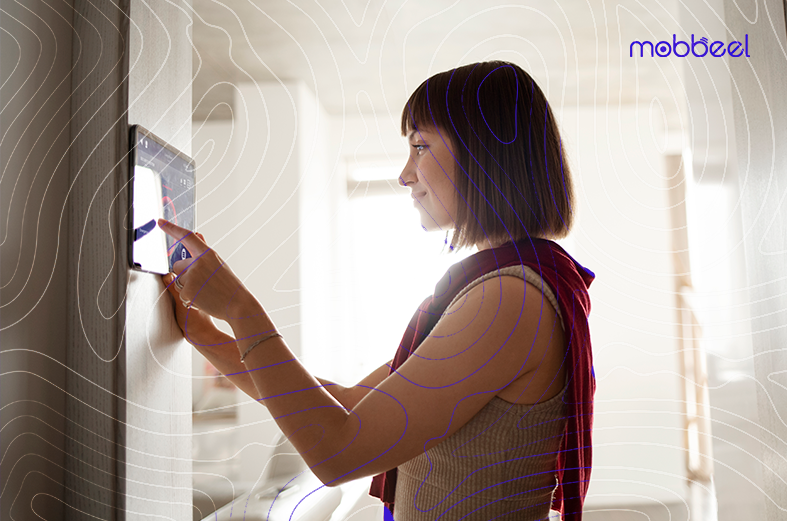Can you imagine a future where your identity is the key to unlocking doors? In this article, we will answer this question through biometric access control. This secure and effective technology uses a combination of unique features of each person to authenticate and authorise access to various places and systems.
What is biometric access?
Biometric access is an advanced access control method that captures and analyses physical or behavioural attributes intrinsic to each individual to authenticate and authorise entry to a facility or system. Rather than relying on keycards, passwords or PINs, this system leverages biological characteristics such as fingerprints, facial recognition, iris, voice or even vein patterns to ensure accurate and secure identification.
Biometric access is not just a technology but also a proof of human nature’s complexity and uniqueness. This concept is based on the idea that each of us has a biological signature that is virtually impossible to replicate.
Types of biometric technologies for access control
Several biometric technologies redefine the way we access critical areas. These include:
- Facial recognition: uses artificial intelligence algorithms to analyse and compare a person’s unique facial features for biometric authentication.
- Fingerprint: is a type of biometrics widely used in mobile devices. In this case, unique fingerprint patterns are captured and compared.
- Iris recognition: This system, considered one of the pioneers in access control, evaluates the unique and complex pattern of the iris for identification. To do so, it captures the pattern of the eye iris through optical systems or sensors and contrasts it by algorithms with existing records of that person. This pattern is unique to each person and virtually unalterable over time.
- Voice recognition: analyses vocal characteristics for authentication, such as tone and rhythm.
- Vein recognition: check out vein patterns under the skin for authentication.
How biometric access control systems work
The way of working of a biometric access control system generally involves connected steps that are performed to authenticate an individual’s identity. The steps that are common to any system are:
- User enrolment: users register in the system by providing their biometric data. During this process, their unique biometric characteristics are captured and recorded.
- Storage: the biometric data is securely stored in the database.
- Scanning or access request: when the user attempts to enter an area through an access point or device, the system scans their biometric features.
- FExtraction: the features are extracted and turned into actionable data. Biometric algorithms parse and convert the captured features into a format that can be compared.
- Comparison: the extracted biometric data is compared with the stored templates.
- Authorisation: the system generates an authentication result based on the similarity between the captured and stored features. If the similarity exceeds a threshold, access is given.
For biometric access control to operate effectively, it is crucial to have a reading or scanning device that captures the biometric factor used in biometric authentication. Furthermore, software is required to transform the captured biometric data into a standard digital format, which verifies the captured data with the stored biometric pattern.
Advantages of biometric access control
Biometric access control presents several advantages, including:
- A very high degree of security: biometric features are unique and challenging to replicate, which increases security.
- Getting rid of passwords: users do not need to remember passwords, reducing access issues.
- Boosting efficiency: authentication processes are fast and frictionless.
- Preventing identity theft: biometric authentication significantly reduces the risk of impersonation.
- Compliance: In some industries, such as healthcare or banking, biometric authentication can help comply with strict security and privacy regulations.
Sustainable biometrics and access control
Another benefit of controlling door, turnstile and barrier access with biometrics is reducing the use of conventional keycards. This innovative approach not only simplifies and secures identification processes but also addresses the concerns inherent in the production and management of plastic cards.
Traditional access card systems often used in enterprise and security environments have a notable environmental impact. Their production requires a combination of natural resources, energy and chemical processes that produce polluting emissions. By eliminating the need for physical cards, the demand for plastic and the processes related to their manufacture are drastically reduced.
It is important to note that sustainability lies not only in reducing plastic production but also in biometric access control’s efficiencies. The verification and entry process means less congestion in access areas and reduced energy consumption.
Biometric access control use cases
The versatility of biometric access control makes it suitable for various applications and industries. These include:
Companies
This type of access control has revolutionised entry and exit management in the corporate environment. Fingerprint-based identification or facial biometrics automates check-in and check-out, eliminates the need for manual records and saves time in HR. Furthermore, it provides records of employees working in production plants, prevents unauthorised personnel from entering warehouses, and controls access to car parks.
Government
Many government facilities store sensitive national security, diplomacy and justice information. Access control ensures that only authorised personnel and visitors have access to these areas and reduces the risk of unauthorised intrusions, leaks of confidential information and acts of terrorism.
Healthcare
Hospitals are crowded spaces, increasing the risk of strangers or emergencies. Access control helps prevent unauthorised entry to critical areas such as operating theatres, intensive care units, oncology, maternity wards and hospital pharmacies. Controlling the flow of people with biometrics decreases the spread of infection and the risk of contamination.
Education
Access control in educational institutions ensures that only authorised persons, such as students and teachers, can enter school facilities while protecting equipment, resources and data for research and student projects. Linked to this is its use for security and order at events and extracurricular activities.
Financial
Banks and other financial institutions have embraced biometric access control to strengthen the security of their facilities and protect assets. In this sense, it is a security measure for transactions and accessing vaults.
Airports
Airports are busy places, so border and access control are vital to maintaining public safety, ensuring citizens’ movement and safe and smooth operations running without incident. Furthermore, it provides that only passengers with valid tickets and permits, such as visas, can take a cross-border flight. It also ensures aviation security and the security of specific areas, such as runways.
Entry-Exit System (EES): document verification and biometrics
Europe is leading the way in biometric border access control with its Entry/Exit System. The main goal of this system is to speed up the entry and exit of individuals and to verify the identity of passengers arriving from outside the Schengen area or passengers expecting to travel to non-EU countries.
This control system at airports and other migration control areas uses a totem that integrates biometric software and devices that efficiently verify identity documents. The process is based on comparing the face of the ID holder with the photo stored in the MRZ and the visual inspection zone of passports.
Is the biometric access control system secure?
The biometric access system is generally considered secure due to the unique and distinctive nature of the biological attributes used for authentication. Nevertheless, like any technology, it may face challenges such as impersonation attacks, which is why security considerations must be addressed to ensure its effectiveness and protect users’ privacy.
Some additional security measures that can ensure maximum protection include data encryption, multi-factor authentication and liveness detection.
Data encryption
Biometric data, such as fingerprints or facial biometric templates, must be encrypted. The encryption process involves transforming biometric data into an unreadable and secure format using mathematical algorithms. It ensures that even if someone accesses the encrypted data, they will only see characters with no helpful information. The only way to make this data readable is by using the corresponding decryption key, which will only be known to people with legitimate access.
Biometric multi-factor authentication
Another critical security layer is multi-factor authentication (MFA). Combining biometric authentication with another method, such as a password or security token, creates a more robust system. While a criminal could spoof one factor, they are much less likely to be able to bypass multiple layers of authentication.
The idea behind two-factor biometric authentication is to add a layer of protection by combining unique and hard-to-replicate elements. While biometric features are inherently secure due to their uniqueness, implementing multi-factor authentication further enhances the system’s security by requiring users to provide multiple types of evidence to verify their identity.
A typical example of multi-factor biometric authentication is facial recognition, together with fingerprint recognition. In this scenario, a user would have to place their face in front of a facial recognition sensor and put their fingerprint on a fingerprint sensor to be authenticated. The above is a typical example of passenger identification at border checkpoints or crossings.
Liveness detection
Attack detection is also an important measure. Biometric systems must be able to identify fraud attempts, such as using photographs instead of real faces at access with facial biometrics. Measures such as liveness detection allow the user’s authenticity to be verified in real time.
Privacy and ethical concerns in access control
Implementing biometric access control raises fundamental privacy and ethical concerns by using personal biometric data for authentication. These matters are crucial due to the unique nature of biometric data, which can reveal highly personal aspects of individuals.
In this sense, data protection regulations, such as the European Union’s General Data Protection Regulation (GDPR) and similar laws in other third countries, are essential to ensure that biometric data collection, storage and processing is done lawfully.
Importance of informed consent
The key focus in the implementation of such systems is informed consent. Users must be informed about what data will be collected, how it will be used and what their rights are about that data.
The storage and processing of biometric data must be safe and secure. As commented in the previous point, security measures should include data encryption and the implementation of cutting-edge security protocols to prevent unauthorised access and data breaches. Furthermore, data storage should be time-limited and justified for legitimate purposes.
Therefore, biometric access control systems should be implemented to ensure authentication and balance innovation and privacy protection.
What is the best biometric access control solution for your company?
The biometric access control solution choice depends on several factors, such as the environment, the level of security required and the budget. Working with providers with a customised approach and expertise in biometric security, such as Mobbeel, is essential to identify the best solution for your business.
MobbID, our multi-metric solution, has been successfully implemented in various industries and is set as a leading biometric security software that can be seamlessly integrated into any system.
Feel free to contact us if you would like to implement an access control system using Mobbeel biometrics, a highly testing solution in the market.

I am a curious mind with knowledge of laws, marketing, and business. A words alchemist, deeply in love with neuromarketing and copywriting, who helps Mobbeel to keep growing.

INDUSTRY PAGE
Discover how we help with airport access processes
The integration of identity verification solutions in the airline and airport industry is essential to modernising border control processes, ensuring traveller security, and enhancing the travel experience.




